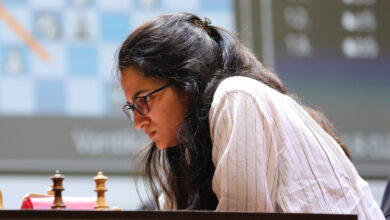US Open: Carlos Alcaraz’s unique brand of talent is evident in his abilities at the net | Tennis News

At the end of the second set of his third-round match against Carlos Alcaraz on Saturday, Dan Evans unleashed a pattern of play from his crafty playbook trying to stay alive in the contest. An excellent body serve was followed a couple of sliced backhands robbing the Spaniard of any pace to dominate from the baseline.
But Alcaraz would not back down. He hit huge forehands until he was given a simple put-away volley at the net. A few points later, defending set point, Evans tried to take a page out of his opponent’s book – supplementing a big serve with big groundstrokes and coming up to the net. Alcaraz would toy with him, sending him trailing with a deft lob before putting away a simple volley across the net. The set, and the two-set lead, were his.
On a dry, warm morning session, Alcaraz put in his best performance in four matches at the US Open so far, to beat Evans 6-2, 6-3, 4-6, 6-3. While the scoreline might not suggest so, the Arthur Ashe stadium crowd bore witness to the show the duo put up with their varied, crafty games.
Evans, aware that he has the unenviable task of contending with the world’s best tennis player, mixed his game up with slices, drop shots, and net play, to contend with the Spaniard’s groundstrokes and weight of hitting. And Alcaraz was equal to all.
Many of the big strengths – big forehand and deceptive drop shot included – in his all-court game have been highlighted in this two-year-long period in which Alcaraz has ascended to the top of the men’s game, coming into Flushing Meadows as the defending champion. But perhaps the most uniquely suited to his well-rounded set of capabilities happens to be his realisation that finishing points at the net give him the best chances to win the rallies he so carefully constructs.
And Evans happened to have the arsenal to be the perfect dancing partner. Of the 238 points played out between the two on Saturday, at least one of the two players approached the net on 117. Evans would approach the net on more occasions, but his success rate (55%), was substantially lesser than that of Alcaraz (79%).
If Evans was incorporating net play into his game to mix things up on purpose, it was Alcaraz’s natural point construction that led him to the net. Well aware of his strengths, most of Alcaraz’s tactical preparation is evidently based around his stronger forehand wing, which he hits clean with power, flatter through the air to push opponents further and further behind the baseline.
The 20-year-old then flexes his impressive physicality – very impressive considering his age – to show the burst of pace in his footspeed to immediately back up huge forehands from the baseline at the net. In dealing with his power, his opponents must match it from the baseline, or find acute angles to beat him when he approaches the net. Most struggle to do either, or both, consently in a five-set match.
This acute point construction has been on display against the very best too. In the two matches at the French Open and Wimbledon that he played against Novak Djokovic this summer, despite Djokovic coming to the net substantially more often, Alcaraz has a higher conversion rate.
Sep 2, 2023; Flushing, NY, USA; Carlos Alcaraz of Spain hits to Daniel Evans of Great Britain on day six of the 2023 U.S. Open tennis tournament at USTA Billie Jean King National Tennis Center. Mandatory Credit: Danielle Parhizkaran-USA TODAY Sports
At Wimbledon, in the first set he lost 1-6 before making a comeback, Alcaraz only came to the net four times. As he gained more confidence through his forehand he approached the net more often. Despite Djokovic coming to the net on 20 more occasions, Alcaraz had marginally higher success rate – 61% compared to the Serb’s 60%.
While speaking to the New York Times, Jimmy Arias, a former doubles Grand Slam champion who runs the well-known IMG academy in the US, observed this particular pattern of play in Alcaraz’s game while noticing him play in America this year. He pointed out that he could not quite reger how Alcaraz is able to find immeasurable power off his forehand while standing deep inside his own court, and then back it up with the speed to come to the net and finish the point off.
While one comparison, with Roger Federer when he saw him blast past Lleyton Hewitt in the 2004 US Open final, did come up, he felt this trait, of finding a clean, powerful forehand and then backing it up at the net in one, effortless-looking motion, was unique to Alcaraz’s strengths. Trying to defend that may be futile. Instead, he says, attacking him is the better option.Most Read
1
India vs Pakan Highlights, Asia Cup 2023: Match called off in Pallekele after rain plays spoilsport
2
Breaking: India’s World Cup team finalised, Sanju Samson misses out
See More
“The only thing you are going to be able to do (to beat him) is out-Alcaraz Alcaraz,” he said. “Good luck with that.”
How Alcaraz constructs a net point
While his signature drop shot may be the more eye-catching weapon in his varied tennis arsenal, Alcaraz’s dominance from the baseline can be summarised in his success at the net. Typically, when constructing points, Alcaraz tends to build them on the basis of his massive forehand, which he uses to push opponents further and further behind the baseline before using his footspeed and court position to come to the net to finish the point off with an easy volley. The only option to win those exchanges for opponents, then, are trying to match his power from the baseline, or finding acute angles to beat him at the net. Either, or both, are hard to do consently over five potential sets.







